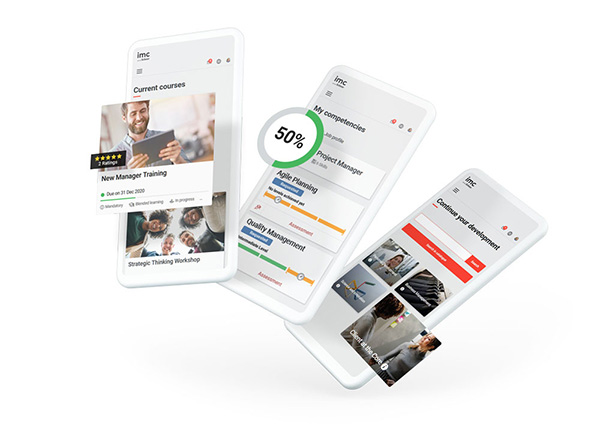
LMS vs LXP - digital learning platform terminology explained
What's an LMS?
What's an LXP?
Other terminology: LLP, LCMS, and LMXP
What are the differences between an LMS and an LXP?
LMS vs LXP - which one's right for you?
Common software integrations
Top reasons to choose a combined LMS and LXP
LMS vs LXP at a glance (table format)

What's an LMS?
"LMS" stands for "learning management system" – a corporate learning platform used for both traditional, top-down style of training as well as decentralised, distributed and blended learning across organisations (LMS integration).

Purpose of an LMS
The key word here is "management". The learning and development (L&D) or HR team will create training content, then distribute it to employees via the LMS. Good, modern LMS solutions also offer assessment tools and provide data on employee progress through training content with easy-to-use learner analytics tools.
Key features of an LMS
Here are some of the key features you should look for if you're choosing an LMS:

Course administration
An LMS should have a strong backbone in managing courses, making it easy to generate, distribute, and keep track of various learning materials. It should also facilitate user management, progress monitoring, and assessment.

Content control
A good LMS should allow you to store and administer various content formats, such as text, images, videos, and audio. It should support the creation and administration of learning journeys – a sequential arrangement of courses that learners can follow to attain certain objectives.

Data analysis and reporting
Detailed reports and analytics are a crucial LMS feature that provide insights into learner's progress, course completion rates, and other significant metrics/KPIs. These insights can be instrumental in refining your training initiatives and evaluating the ROI on your LMS and content investment.

Simple user interface
The LMS should have an intuitive, user-friendly interface that's easy to navigate. Its design should be responsive and compatible with mobile devices, enabling learners to access their courses from any location

Security
It's essential for an LMS to be secure. The LMS needs to safeguard the privacy of learner's data, and cybersecurity within your learning platform should be taken as seriously as it is across the rest of your IT systems. Features such as robust passwords, role-based access privileges, and data encryption should be part of the system.

System integrations
An LMS is generally interoperable, extensible, and easily scalable. It should integrate with your other employee platforms, such as your human resources systems and customer relationship management (CRM) software. This integration facilitates data-sharing across platforms and allows for task automation.
The list above covers essential LMS features and LMS integration. You will weight specific functionalities differently based on your organisation's unique needs and goals. However, all the above key features are fundamental for any LMS designed to deliver and monitor effective modern enterprise training.

Benefits of an LMS
An LMS offers a range of advantages for both organisations and learners. These include:

Enhanced efficiency and productivity
LMS aids in simplifying the training procedure, facilitating the creation, distribution, and tracking of training programs. This process efficiency liberates time for learners and administrators to concentrate on other duties. It also helps ensure that training is conducted promptly and within budget.

Learner engagement and retention
By crafting interactive and immersive learning experiences, an LMS helps maintain learner engagement and motivation. This external factor contributes to a better retention of knowledge and skills, while minimising the dropout rate of new hires and trainees.

Tighter compliance
An LMS provides the ability to monitor compliance with regulatory requirements, such as health and safety or financial reporting. A well trained workforce aids organisations in fulfilling their legal obligations and helps shield companies from liabilities in case of an incident.

Better data collection and analysis
LMSs facilitate data-gathering on learner advancement, performance, and involvement. This data is harnessed to improve training programme design and delivery, and to track the company's return on investment for training initiatives.

Scalability
An LMS can be adjusted to cater to organisations of all scales, allowing them to start with a compact LMS and expand as their training demands grow.

Cost-efficiency
An LMS is a cost-effective training delivery tool because it reduces the dependence on instructor-led training but can also unlock streamlined booking processes for blended and geographically distributed face-to-face learning courses, in-person course modules, and employee training tasks.

Accessibility
With an LMS, training becomes more accessible because employees can access the platform from any location with an internet connection.

Flexibility
LMSs deliver training in diverse formats such as live online courses, self-paced courses, and blended learning programmes.

Customisation
HR and L&D professionals can personalise their LMS to cater to an organisation's specific requirements in various areas, such as branding, learning goals, and learner demographics.
If your organisation aims to enhance its training procedures, considering a modern enterprise LMS is an excellent choice. By simplifying the training process, enhancing engagement and retention, and offering superior data collection and analysis, an LMS can help you boost your training ROI and achieve your wider business L&D objectives.

Maximising the impact of your LMS for superior learning outcomes
Here's advice on maximising the effectiveness and impact of a learning management system (LMS):

Select the best LMS for your needs
With many LMS options available, it's crucial to find one that caters to your organisation's specific needs. Take into account your company size, the type of training you wish to implement, and your financial resources.

Strategise your training
Prior to initiating the use of your LMS, devising a detailed training plan is essential. This encompasses outlining your learning goals, formulating a curriculum, and crafting educational resources.

Create engaging content
The learning material hosted on your LMS should stimulate learner engagement and be interactive to maintain learner motivation. This is likely to include the use of videos, animations, quizzes, and other interactive components.

Customise the learning journey
The LMS ought to enable you to tailor the learning experience for each training participant. This may involve letting learners select their own learning pathway, establish their own objectives, and monitor their own advancement.

Offer support
Learners should have easy access to support if they encounter difficulties with the LMS or their training. This could mean supplying guidance documents, live chat support, or a forum for learners to raise questions and share their learning experiences.

Monitor learning outcomes
The LMS should equip you with the ability to observe the outcomes of your training. This entails tracking learner progress, performance, and involvement. This data can be employed to refine the design and delivery of your training schemes.
By following these recommendations, you can optimise the impact your LMS and enhance the efficacy of your training initiatives.

What's an LXP?
"LXP" stands for "learning experience platform". LXPs are solutions designed to encourage and facilitate learner-led training content exploration and learning selection.

Purpose of an LXP
Key functions of a learning experience platform (LXP) include:

Tailoring the learning journey
LXPs can use artificial intelligence (AI) and machine learning to individualise the learning experience for each learner. This could involve content suggestions based on the learner's interests, ambitions, and progression.

Facilitating self-guided learning
LXPs are engineered to motivate self-guided learning. As a result, learners have the autonomy to manage their learning by choosing what, when, and how they want to learn.

Encouraging teamwork
LXPs can be employed to enhance collaboration among learners. This could involve providing platforms for idea sharing, questioning, and feedback.

Advocating continuous learning
LXPs are designed to endorse continual learning, meaning learners can access educational content at any time, from any location, and on any device.
While LXPs are relatively novel technology, their popularity is surging. As more organisations embrace enterprise LXPs, we anticipate seeing more innovative applications of these platforms to enhance employee learning and development.
Key features of an LXP
The differentiating attributes of an LXP (compared to an LMS) include:

Personalisation
LXPs employ artificial intelligence (AI) and machine learning to tailor the learning experience for each learner. This can be accomplished by suggesting content informed by the learner's interests, objectives, and progress.

Self-guided learning
LXPs are constructed to promote self-guided learning, enabling learners to direct their own learning by choosing what, when, and how they want to learn.

Collaboration
LXPs offer tools to stimulate collaboration among learners, which can include the sharing of ideas, posing questions, and providing feedback.

Continuous learning
LXPs are designed to advocate for continuous learning, allowing learners to access educational content anytime, anywhere, and on any device.

Content curation
LXPs can curate content from diverse sources, both internal and external, helping learners to find content that aligns with their interests and goals.

Social learning
LXPs enable social learning by providing tools for learners to connect with one another and share knowledge, fostering peer-to-peer learning and relationship building.

Preference and behaviour analytics
LXPs collect data on learner engagement, progression, and performance. This data can be used to refine the design and delivery of learning content and track the return on investment of learning initiatives.
The above are merely a few of the main features of an LXP. As the LXP market matures, we anticipate witnessing the introduction of further innovative features and functionalities.

Benefits of an LXP
Here are some advantages of using an LXP for your enterprise training:

Maximising individual interests and talents
Because learners are free to explore content as they see fit, they are more likely to find their own sweet spot between interests, training needs and professional goals than if training is dictated by managers. This highly motivated learning is more likely to bring out the unique potential among individuals, and in turn, drive organisational improvement – perhaps in unexpected ways.

Heightened engagement
LXPs can bolster learner engagement by offering a more personalised and interactive learning experience.

Better learning outcomes
LXPs can enhance learning outcomes by granting learners access to a broader content range and encouraging them to steer their own learning.

Cost reduction
LXPs can cut costs by lessening the demand for instructor-led training and offering a more efficient training delivery method.

Improved compliance
LXPs can enhance compliance by providing a means to monitor learner progress and to ensure learners are fulfilling their training obligations.
In conclusion, if you're seeking a way to upgrade your organisation's L&D capability and foster a culture of learning, an LXP is a worthwhile option to consider.
Maximising the impact of your LXP
Here are specific ways for learners to maximise the utility of a learning experience platform (LXP):

Discover content that aligns with your interests and objectives.
The LXP is capable of suggesting content based on your previous learning activities, personal interests, and set goals.

Monitor your progress and maintain motivation.
The LXP can chart your journey through your chosen learning path and provide a comparative view of your progress with respect to other learners.

Collaborate with fellow learners.
The LXP can furnish tools that enable you to work with others on projects, exchange ideas, and raise enquiries.

Connect with subject matter experts.
The platform can help you or your learners to discover subject matter experts who can address your queries and offer guidance.
By following the tips above, you can optimise the use of your LXP and enhance your learning journey.

Other terminology: LLP, LCMS, and LMXP
LLP
In the sphere of elearning, "LLP" stands for "learning and learning partnership". This is a cooperative alliance between two or more entities involved in the conception and distribution of elearning material.
Examples of LLPs:

Open University
A distance learning university based in the UK, Open University has collaborated with various organisations to produce elearning content.

Khan Academy
A non-profit providing free, world-class education to anyone, anywhere, Khan Academy has joined forces with several organisations, including Google and the Bill & Melinda Gates Foundation, to create elearning content.

Coursera
An online learning platform offering courses from top universities and organisations globally, Coursera has partnered with various entities, including Stanford University and the University of Pennsylvania, to generate elearning content.
LCMS
A learning content management system (LCMS) is a software platform that aids organisations in the creation, management, delivery, and tracking of learning content. It's a robust tool that can bolster organisations' training programmes and help accomplish business objectives. Typical features of an LCMS include:

Content creation
LCMSs give users the ability to construct and modify learning content, including courses, modules, and activities.

Content management
LCMSs facilitate the organisation, tagging, and searching of learning content, streamlining content administration for users.

Content delivery
LCMSs enable users to distribute learning content to learners through various methods like online courses, mobile applications, and intranets.

Content tracking
LCMSs provide tools to monitor learner progress, including metrics like completion rates, scores, and time spent on content.
LMXP
Does it matter what you call your elearning platform?
As existing learning platforms add ever more features, the lines between them are becoming increasingly blurred.
If what was traditionally thought of as an LMS adds content exploration and personalisation features associated with an LXP - what is the result? Furthermore, some e-learning companies coin new terminology to try and create demand for a new 'market' where they are first in place to capture that demand.
Ultimately, the term 'learning platform' is one that has endured as long as elearning because it can welcome any and all use cases, features, and benefits.
What are the differences between an LMS and an LXP?
Learning management systems (LMSs) and learning experience platforms (LXPs) are both software platforms that aid organisations in delivering and overseeing employee learning. Nevertheless, there are significant differences between the two.
Traditionally, LMSs are primarily concerned with managing learning content, including courses, modules, and activities. They also monitor learner progress and generate reports on completion rates, scores, and the duration of content engagement.
Conversely, LXPs are engineered to offer a more personalised and engaging learning experience. They employ artificial intelligence (AI) and machine learning to suggest content tailored to the learner's interests, objectives, and progression. Furthermore, LXPs promote autonomous learning and foster collaboration among learners.

LMS vs LXP - which one is right for you?
Generally, LMSs are suitable for organisations that require structured training across diverse topics. LXPs, on the other hand, are optimal for organisations aiming to offer their learners a more personalised and engaging learning experience.
Here are some additional factors to consider when deciding between an LMS and an LXP:

Organisation size
An LMS might be adequate if your organisation is small. However, for larger organisations with a higher number of learners, an LXP could be more beneficial due to its scalability.

Type of training to be delivered
An LMS can be an ideal choice if you need to administer structured training on various topics. Conversely, if your objective is to offer a more customised and interactive learning experience, an LXP could be the better choice.

Available budget
LMSs are generally more affordable than LXPs. However, the cost of an LXP can fluctuate depending on the features required.
The optimal choice between an LMS and an LXP depends on your specific needs and goals. If you're unsure which platform is most suitable for your circumstances, consulting with a learning technology advisor is a valuable step.
Common software integrations
So that your LMS/LXP fits seamlessly into your existing tech stack, you'll want to integrate it with relevant software. This way, your learning platform will reduce admin time and headaches, rather than add to them.
Here are common LMS/LXP software integrations to look for:
- HR/HCM software, like Workday or SAP
- CRM, like Salesforce
- Collaboration Software, like Microsoft Teams
- ecommerce, like PayPal or Shopify
- elearning content, like LinkedIn Learning or YouTube
Top reasons to choose a combined LMS and LXP
There are several compelling reasons to opt for a combination of LMS and LXP:

Greater flexibility
The blend of an LMS and LXP offers the structured training proficiency of an LMS, alongside the customised and engaging experience of an LXP. This can be advantageous for organisations needing to deliver diverse types of training to their learners.

Cost reduction
Merging an LMS and LXP can result in financial savings for organisations by removing the necessity to buy and manage two distinct platforms.

Ease of use
A unified LMS and LXP system can be simpler to navigate than two separate platforms, as learners only have to familiarise themselves with one interface. This can decrease the learning curve and potential frustration for both learners and administrators.

Increased learner engagement
By offering a more customised and engaging learning experience, a combined LMS and LXP can enhance learner engagement. This can lead to improved learning results and heightened retention rates.
LMS vs LXP at a glance
| LMS | LXP | |
|---|---|---|
| Focus | Managing learning content | Providing a personalised and interactive learning experience for content exploration |
| Features | Content authoring, content management, content delivery, content tracking | Content curation, social learning, analytics, personalisation, self-directed learning |
| Target audience | Employees, customers, partners. | Employees. |